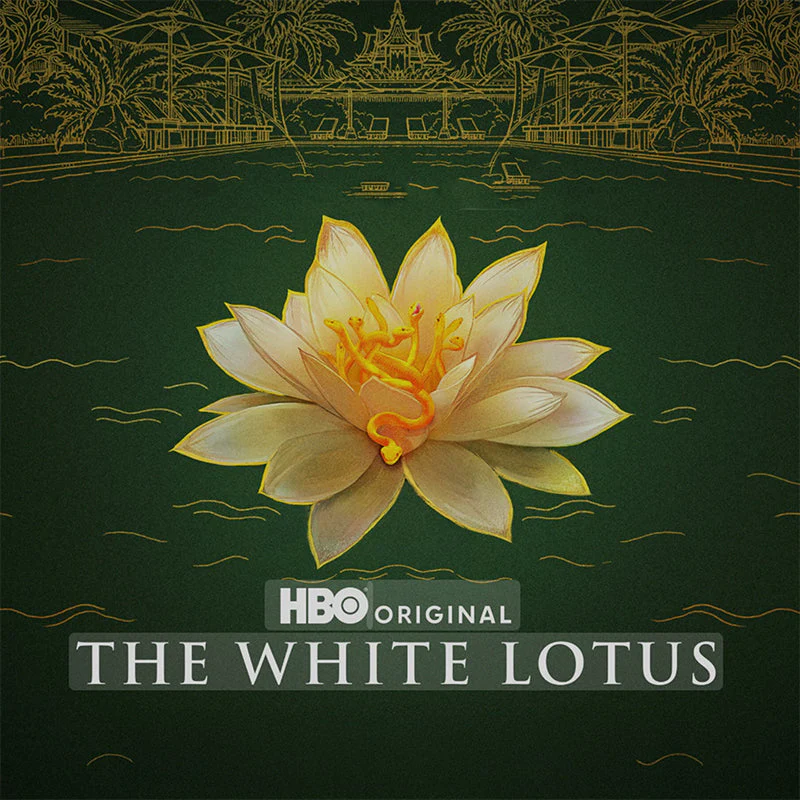
13 Jun “The White Lotus” Effect
WHY UNDERSTAND “THE WHITE LOTUS” EFFECT
At Travel with Care, we help destinations understand and manage the ripple effects of traveler behavior. As global media increasingly shapes where and how people travel, it’s important for DMOs to anticipate not just demand, but also its impacts.
The White Lotus effect highlights the complex relationship between pop culture, tourism demand, and destination sustainability1. The show “The White Lotus” glamorizes luxury2, escapism, and privilege, but often ignores the socio-cultural and environmental realities of tourism3. Travelers are not always aware that what they see on screen is often curated and fictionalized4. The show centers on wealthy, predominantly Western characters, leaving local staff and culture in the background or portrayed as subservient. Much of the spending by tourists influenced by shows like “The White Lotus” goes to large hotel chains, often foreign-owned, rather than local businesses.
Destinations affected by “The White Lotus” effect can face overtourism concerns after global exposure, leading to rising costs of living, resource depletion, and community displacement5. Understanding the White Lotus effect encourages DMOs to anticipate and manage such surges with sustainability strategies. The White Lotus effect is a powerful reminder that tourism doesn’t exist in a vacuum. It is shaped by media, driven by global demand, and felt deeply at the local level6. Understanding “The White Lotus” effect helps DMOs prepare for potential tourism surges driven by media exposure. By identifying early indicators like increased search traffic or media buzz, destinations can begin scenario planning, craft messaging that aligns with their sustainability goals, and promote local businesses and cultural authenticity over luxury escapism.
WHAT IS “THE WHITE LOTUS” EFFECT
“The White Lotus effect” in tourism refers to the phenomenon where a popular TV show or movie, like HBO’s The White Lotus, boosts interest and travel to the real-world locations where the show was filmed7. The term “White Lotus effect” specifically emerged after the global success of The White Lotus series, which was filmed in luxury resorts in Maui (Hawaii), Taormina (Sicily, Italy), and Koh Samui (Thailand).
However, it is not a new concept as movie/film tourism often attracts visitors where viewers become inspired to visit a destination after seeing it portrayed on screen8,9. For example, Senoia, Georgia, USA gained popularity from the show, “The Walking Dead.”10 Similarly, “The Sound of Music” was filmed in Salzburg, Austria and attracted many tourists itching to take a tour to explore various locations around the city where the movie shot scenes11.
The White Lotus effect or movie/film tourism in general highlights the powerful role media plays in shaping travel behavior12,13. While it can bring economic benefits and visibility to destinations, it also calls for careful tourism planning to avoid negative consequences associated with rapid, unplanned growth.
HOW IT AFFECTS A DESTINATION
Shows like The White Lotus spark travel dreams. However, if unchecked, they can lead to real-world challenges. Understanding and planning for the White Lotus effect gives DMOs a strategic edge in managing demand responsibly and shaping tourism that cares for places and people.
The White Lotus has three seasons. Each season was filmed in a different destination resort. The first season was filmed at the Four Seasons Resort Maui at Wailea. They experienced a 425% increase in website visits and a 386% rise in availability checks, indicating a substantial boost in traveler interest7. The heightened attention led to increased bookings at high-end resorts, benefiting the local luxury tourism industry. However, the influx of tourists added pressure to Maui’s infrastructure, leading to concerns about sustainability and resource management. Furthermore, the increased visitor numbers raised issues related to waste management and environmental degradation in sensitive areas.
The second season was filmed in Taormina, Sicily, Italy. The show’s setting led to a surge in bookings at local hotels and businesses. Sicily gained international attention as a luxury travel destination, attracting visitors interested in its culture and scenery14. However, the sudden influx of tourists led to overcrowding in popular areas, straining local resources and affecting residents’ quality of life. Additionally, the portrayal of Sicily in the show risked oversimplifying its rich culture, leading to concerns about the authenticity of tourist experiences.
Finally, the most recent season was filmed in Koh Samui, Thailand. The anticipation of the show’s third season led to a surge in searches and bookings for the island, boosting its tourism profile15. Even before the season aired, the expected rise in tourism presented opportunities for local businesses and the hospitality sector to benefit economically. However, Koh Samui faces challenges like water scarcity and waste management issues, which could be exacerbated by increased tourist numbers. Moreover, the island’s infrastructure may struggle to cope with a sudden influx of visitors, leading to potential degradation of natural resources and local culture.
WHAT DESTINATIONS CAN DO
The White Lotus effect underscores how media exposure can quickly transform a destination’s tourism profile. But with foresight, DMOs can turn pop culture interest into a sustainable opportunity.
- Monitor spikes in search trends after a destination appears in major shows/movies. Use that momentum to direct travelers toward off-peak seasons, lesser-known attractions, or local guides.
- Craft destination messaging that highlights cultural authenticity, local businesses, and responsible behavior.
- Manage carrying capacity by encouraging shoulder-season travel, spreading out visitation geographically, and educating travelers before arrival.
- Partner with influencers or content creators who showcase the destination beyond the glossy resort image, highlighting real culture, community voices, and environmental concerns.
DMOs mentioned
https://www.gohawaii.com/islands/maui
https://www.visitsicily.info/en/localita/taormina/
https://www.visitsamui.org/
Other helpful materials
https://www.bbc.com/travel/article/20250213-how-tv-and-film-locations-impact-travel-the-white-lotus-effect
https://www.ceotodaymagazine.com/2025/03/the-white-lotus-effect-how-filming-locations-boost-global-tourism/
https://medium.com/@clnelson/the-white-lotus-effect-balancing-popularity-and-authenticity-6692826cbf1f
https://newromantimes.substack.com/p/sicily-and-the-white-lotus-effect
https://www.theguardian.com/travel/2022/oct/28/were-booked-until-april-2023-the-white-lotus-effect-on-sicilys-glitziest-town
https://worldcrunch.com/food-travel/tourism-in-southern-italy/
https://www.travelweekly.com/Travel-News/Hotel-News/White-Lotus-series-generates-interest-Sicily
https://skift.com/2025/02/22/the-dark-side-of-the-white-lotus-effect/
https://www.forbes.com/sites/emesemaczko/2025/03/13/stop-chasing-the-white-lotus-hype-koh-samui-is-already-4x-denser-than-paris/
https://samui-island-realty.com/2025/01/23/unveiling-the-white-lotus-koh-samui-phenomenon/
Neil, M. R., & Wyer, S. C. (2023). ‘Sicily Can Be Very Seductive’: The White Lotus and the Transnational ‘Making’ of the Mediterranean. The Italianist, 43(2), 241–261. https://doi.org/10.1080/02614340.2023.2256064
Connell, Joanne. “Film Tourism – Evolution, Progress and Prospects.” Tourism Management, vol. 33, no. 5, Oct. 2012, pp. 1007–1029, www.sciencedirect.com/science/article/pii/S0261517712000404, https://doi.org/10.1016/j.tourman.2012.02.008.
Beeton, S. (2010). The Advance of Film Tourism. Tourism and Hospitality Planning & Development, 7(1), 1–6. https://doi.org/10.1080/14790530903522572
References
1. Forward Pathway. (2025, April 2). The White Lotus Effect: Cultural Impact, Tourism Reshaping, and Sustainable Development. Forward Pathway. https://www.forwardpathway.us/the-white-lotus-effect-cultural-impact-tourism-reshaping-and-sustainable-development
2. Sheckells, M. (2025, April 3). The White Lotus Effect: How HBO’s Hit Show Is Redefining Luxury Travel Trends. Business Traveler USA. https://businesstravelerusa.com/travel/the-white-lotus-effect/
3. Benjamin Turner. (2025, April 8). The White Lotus Effect: How HBO’s Hit Series Is Redefining Travel, Style, and Brand Strategy. Compartes Chocolates | Gourmet Chocolate Gifts. https://compartes.com/blogs/journal/the-white-lotus-effect
4. Tzanelli, R. (2007). The Cinematic Tourist: Explorations in Globalization, Culture and Resistance. Routledge. https://doi.org/10.4324/9780203940105
5. Eviota, L. (2025, March 1). The ‘White Lotus Effect’ Makes Overtourism in Thailand Worse. https://diinsiderlife.com/index.php/2025/03/01/white-lotus-effect-makes-overtourism-in-thailand-worse/
6. Connell, J. (2012). Film tourism – Evolution, progress and prospects. Tourism Management, 33(5), 1007–1029. https://doi.org/10.1016/j.tourman.2012.02.008
7. Hall, L. (2025, February 16). Measuring the “White Lotus effect”: How TV and film locations impact travel. https://www.bbc.com/travel/article/20250213-how-tv-and-film-locations-impact-travel-the-white-lotus-effect
8. Oshriyeh, O., & Capriello, A. (2022). Film-Induced Tourism: A Consumer Perspective. In D. Jaziri & R. A. Rather (Eds.), Contemporary Approaches Studying Customer Experience in Tourism Research (pp. 223–244). Emerald Publishing Limited. https://doi.org/10.1108/978-1-80117-632-320221022
9. Quintal, V., & Phau, I. (2015). The role of movie images and its impact on destination choice. Tourism Review, 70(2), 97–115. https://doi.org/10.1108/TR-03-2014-0009
10. Ho, R. (2022, September 6). How zombies transformed Senoia. Georgia Entertainment Scene (The Atlanta Journal-Constitution).
11. Biswas, S. D. (2022, August 1). The Sound of Music: Where Was the Musical Movie Filmed? https://thecinemaholic.com/where-was-the-sound-of-music-filmed/
12. Spears, D., Josiam, B., Kinley, T., & Pookulangara, S. (2013). Tourist See Tourist Do: The Influence of Hollywood Movies and Television on Tourism Motivation and Activity Behavior. Hospitality Review, 30(1). https://digitalcommons.fiu.edu/hospitalityreview/vol30/iss1/4
13. Choi, H.-M., & Kessler, D. (2025). The Role of the Korean Media in Shaping Sustainable Tourism Among American Audiences. Sustainability, 17(7), Article 7. https://doi.org/10.3390/su17073253
14. Seymore, C. (2025, March 28). ‘The White Lotus’ boosts international economies, tourism. ‘The White Lotus’ Boosts International Economies, Tourism – The Post. https://www.thepostathens.com/article/2025/03/white-lotus-international-economies-tourism
15. Stodola, S. (2025, February 20). How the ‘White Lotus Effect’ Is Changing Where People Choose to Travel. Teen Vogue. https://www.teenvogue.com/story/white-lotus-season-3-tourism-thailand-koh-samui

